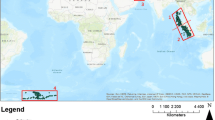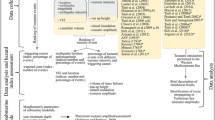Abstract
The historical tsunamigenic event of 21 July AD 365 destroyed several coastal locations in the Eastern Mediterranean region. The foremost destructive impacts were recorded in Crete and Egypt. The present study re-examines the effect of location, direction, height and time of travel of the tsunami towards the Egyptian coast. Evidently, this tsunamigenic event is related to an earthquake which is identified with a Hellenic Arc subduction-zone event of great magnitude, M > 8, as manifested by up to 9 m uplift in western Crete. The maximum run-up height distribution in the front of the Nile Delta was about 9.5 m in Alexandria, while those of the neighboring cities were 7.1 m, 4.9 m, and 1.9 m at Rashid, Damietta and El-Arish, respectively. Data obtained from this study is essential to evaluate the tsunami hazards along the Egyptian coast.
Similar content being viewed by others
References
Abe, H., Y. Sugeno, and A. Chigama (1990), Estimation of the height of the Sanriku Jogan 11 earthquake-tsunami (AD 869) in Sendai Plain, Zishin 43, 513–525.
Aida, I. (1974), Numerical computation of a tsunami based on a fault origin model of an earthquake, Zishin 27, 141–154.
Aida, I. (1975), Numerical experiments of the tsunami associated with the collapse of Mt. Mayuyama in 1792, Zishin 28, 449–460.
Aida, I. (1984), An estimate of tsunamis generated by volcanic eruptions - the 1741 eruption of Oshima-Ohshima, Hokkaido, Bull. Earthq. Res. Inst. Univ. Tokyo 59, 519–531.
Ambraseys, N.N. (2001), Far-field effects of Eastern Mediterranean earthquakes in Lower Egypt, J. Seismology 5, 263–268.
Ambraseys, N.N., C.P. Melville, and R.D. Adams (1994), The Seismicity of Egypt, Arabia, and the Red Sea, Cambridge Univ. Press, Cambridge, UK.
Guidoboni, E., A. Comastri, and G. Traina (1994), Catalogue of Ancient Earthquakes in the Mediterranean Area up to the 10th Century, Instituto Nazionale di Geofisica, Rome, 504 pp.
Hamouda, A.Z. (2002), Tsunami data base of the Eastern Mediterranean, Bull. Nat. Inst. Oceanogr. Fish. 28, 437–452.
Hamouda, A.Z. (2006), Numerical compuations of 1303 tsunamigenic propagation towards Alexandria, Egyptian coast, J. African Earth Sciences 44, 37–44, DOI: 10.1016/j.jafrearsci.2005.11.005.
Hatori, T. (1986), Classification of tsunami magnitude scale, Bull. Earthq. Res. Inst. Univ. Tokyo 61, 503–515.
Intergovernmental Oceanographic Commission (1987), International Bathymetric Chart of the Mediterranean, scale 1:1,000,000 at 38° lat. 10 sheets with heights and depths in meters, Ministry of Defence, Leningrad, USSR, under the authority of IOC (UNESCO), single sheet at 1:5,000,000.
ISC (2005), Earthquake Catalogue, Intern. Seism. Center, Newbury (computer file).
Iwasaki, T., and A. Mano (1979), Two-dimensional numerical simulation of tsunami run-ups in the Eulerian description, Proc. 26th Conf. Coastal Eng., JSCE, 70–74.
Jacques, F., and B. Bousquet (1984), Le cataclymedu 21 Juiller 365. Association pour la promotion et la duffusion des connaissancaa archeologiques, Valbonne, 183–198.
Koshimura, S.I., F. Imamura, and N. Shuto (2001), Characteristics of tsunamis propagating over oceanic ridges: Numerical simulation of the 1996 Irian Jaya earthquake tsunami, Natural Hazards 24, 213–229.
Le Pichon, X., and J. Angelier (1979), The Hellenic Arc and trench system: A key to the neotectonic evolution of the eastern Mediterranean area, Tectonophysics 60, 1–42.
Lorito, S., A. Piatanesi, M.M. Tiberti, and R. Basili (2006), Earthquake-induced tsunamis in the Mediterranean Sea: scenarios of potentials threats to Southern Italy, European Geosciences Union, General Assembly 2006, Vienna, 2–7 April 2006, Session Natural Hazards NH6.01, Abstract N, EGU06-A-09202, 85–95.
Loubrieu, B., C. Satra, and R. Cagna (2001), Cartography by multibeam echosounder of the Mediterranean Ridge and surrounding areas, Ifremer/CIESM, Brest, France.
Mantovani, E., D. Albarello, D. Babbucci, C. Tamburelli, and M. Viti (2000), Genetic mechanism of back-arc opening: Insights from the Mediterranean deformation pattern. In: E. Boschi, G. Ekström, and A. Morelli (eds.), Problems in Geophysics for the New Millennium, Proceedings Erice 1999, Istituto Nazionale di Geofisica, Roma, Italy, 151–178.
NOAA (2005), Earthquake Catalogue, National Oceanic and Atmospheric Administration, Denver.
Papadopoulos, G.A. (1991), Seismicity and related phenomena in the Hellenic Arc: their influence on the Eastern Mediterranean region. In: M.J. Salem, A.M. Sbeta, and M.R. Bakbak (eds.), The Geology of Libya, vol. 4, Elsevier, Amsterdam, 2441–2449.
Pirazzoli, P.A., J. Laborel, and S.C. Stiros (1996), Earthquake clustering in the Eastern Mediterranean during historical times, J. Geophys. Res. 101, 6083–6097.
Riad, S., M. Ghalib, M.A. El Difrawy, and M. Gamal (1996), Probabilistic seismic hazard assessment in Egypt, First Annual Meeting of the IGCP Project 382, Cairo, 1–42.
Riad, S., A. Tealeb, S. Hadidy, N. Basta, A. Mohamed, M.A. Aziz, and H.A. Khalil (2003), Ancient earthquakes from some Arabic sources and catalogue of Middle East historical earthquakes, UNESCO pressed.
Royden, L.H. (1993), Evolution of retreating subduction boundaries formed during continental collision, Tectonics 12, 629–638.
Shuto, N. (1991), Numerical simulation of tsunamis - Its present and near future, Natural Hazards 4, 171–191, DOI: 10.1007/BF00162786.
Shuto, N. (1993), Tsunami intensity and disasters. In: S. Tinti (ed.), Tsunamis in the World, Kluwer Academic Publishers, Dordrecht, 197–216.
Shuto, N. (1997), A natural warning of tsunami arrival. In: G. Herbenstreit (ed.), Perspectives on Tsunami Hazard Reduction, Kluwer, Dordrecht, 157–173.
Shuto, N., G. Goto, and F. Imamura (1990), Numerical simulation as a means of warning for near-field tsunami, Coast. Eng. Japan 33, 173–93.
Soloviev, S.L. (1970), Recurrence of tsunamis in the Pacific. In: W.M. Adams (ed.), Tsunamis in the Pacific Ocean, East-West Center Press, Honolulu, 149–163.
Stiros, S.C., and A. Drakos (2006), A fault-model for the tsunami-associated, magnitude > 8.5 Eastern Mediterranean, AD 365 earthquake, Z. Geomorphol. 146, 125–137.
Stuartand, A.M., and A.R. Humphries (1996), Dynamical Systems and Numerical Analysis, Cambridge University Press, Cambridge, 709 pp.
Author information
Authors and Affiliations
Corresponding author
Rights and permissions
About this article
Cite this article
Hamouda, A.Z. A reanalysis of the AD 365 tsunami impact along the Egyptian Mediterranean coast. Acta Geophys. 58, 687–704 (2010). https://doi.org/10.2478/s11600-009-0032-7
Received:
Accepted:
Published:
Issue Date:
DOI: https://doi.org/10.2478/s11600-009-0032-7




